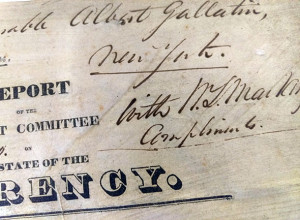This documents the exhibition held at Senate House Library 1 Oct – 27 November 2015 with items from Senate House Library and the Institute of Historical Research collections. The exhibition was curated by Benjamin Bankhurst, Postdoctoral Fellow in North American History at the School of Advanced Study 2014-2015 with assistance from Mura Ghosh and the conservation team at Senate House Library.
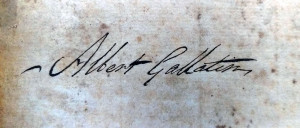
Front leaf from Laws of the Commonwealth of Pennsylvania. Republished by Alexander James Dallas, Philadelphia: Hall and Sellers, 1793 Vol. 2.
Several items in the US collections once belonged to prominent early American statesman Albert Gallatin (1761-1849). These works came to the libraries as part of the Conway bequests of the 1920s and 30s and represent a selection of Gallatin’s – much larger – personal library. This small exhibition celebrates items in our collections relating to Gallatin’s political career. Gallatin played a significant role in the political and economic debates of the United States during the Antebellum period.
Introduction
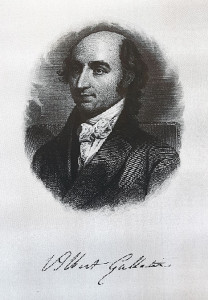
From The life of Albert Gallatin Henry Adams Philadelphia; London: J.B. Lippincott & Co, 1879 – SHL
Albert Gallatin was born into a prominent merchant family in Geneva where he spent his childhood and adolescence. Orphaned at an early age, he spent much of his youth as a student in residency at the Geneva Academy. His enthusiasm for French philosophers, especially Jean-Jacques Rousseau, and the magnetic draw American revolutionary ideology led the young Gallatin to consider sailing for the United States. In 1780, at the age of 19, Gallatin arrived in Boston and later settled in western Pennsylvania.
It was in Pennsylvania that he first became embroiled in the fractious politics of the new nation. In 1790 he won a seat in the state senate before becoming a US senator for Pennsylvania in 1793. He was later elected to the House of Representatives for Pennsylvania’s 12th district, an office he occupied from 1795 to 1801. Gallatin was instrumental in negotiating the peaceful resolution of the Whiskey Rebellion, a protest movement in western Pennsylvania. As a resident of the western counties with a track record of opposition to the Federalist bloc in congress, Gallatin and helped to convince many of the movement’s leaders to stand down before the arrival of Federal troops.
He became the Republican party leader in the House and was a leading critic of the Adams administration and the national debt. Following the spectacular electoral victory of Thomas Jefferson and his Republican allies in 1800, Gallatin was appointed the fourth Secretary of the Treasury. In 1816 he helped charter the Second Bank of the United States. He then spent most of the subsequent decade abroad, first as the US Minister to France (1816-1823) and then to Britain (1826-27). Upon returning to the United States, Gallatin spent the last twenty years of his life in Astoria, New York.
Throughout his career Gallatin pursued projects to promote learning and the Arts in his adopted country. He first developed an interest in the ecology and geography of North America as well as Native American culture while studying at the Geneva Academy. He maintained an interest in these subjects throughout his career in the United States. In 1803 and 1804, he helped plan the Lewis and Clark expedition to the lands acquired by the United States as a result of the Louisiana Purchase. During his New York years, after he had retired from political office, Gallatin became involved in several civic and national improvement campaigns. In 1831 he backed efforts to found a university for New York’s growing commercial classes. The result was the establishment of New York University. Gallatin also became the President of the American Ethnological and New York Historical Societies. He published two works on Native American culture: A Table of Indian Languages of the United States (1826) and Synopsis of the Indian Tribes of North America (New York, 1836). Finally, he continued to write pamphlets and deliver speeches on national economic and political issues, many of them having to do with the western expansion of the United States (for example, he published a pamphlet on the peace with Mexico in 1848).
The United States and the French Republic, 1794-1800

General Report of such vessels of the United States as have been taken… by the French, 1796, bound with other pamplets in: ‘Reports Etc., 1 Session, 7 Congress – 1801-2’ (vol. 1) – IHR
The French Republic, suspicious of America’s policy of neutrality during the wars between Britain and France following the signing of the Jay Treaty, begun to attack American shipping in the Atlantic. This official report was published by the government of the United States and shows where US ships were captured, where they were taken, and what happened to them. The foreign policy pursued by the John Adams Administration was central to partisan political atmosphere of the late 1790s.
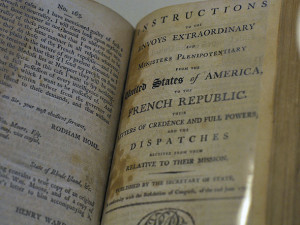
Instructions to the Envoys Extraordinary and Ministers Plenipotentiary from the United States of America to the French Republic Philadelphia: Printed by W. Rofs, 1798 Bound in: ‘Negotiations with France, 1796-98’ – IHR
The relationship between the French Republic and the United States deteriorated throughout the late 1790s. In 1794, the US and British governments signed the Jay Treaty, an action that undermined the proclaimed neutrality of The United States in the ongoing conflict between Britain in France. In 1796, the French Republic refused to receive American envoys unless they were willing to pay bribes. When this was revealed to the American public during the “XYZ Affair”, a firestorm of anti-French sentiment swept the nation, temporarily increasing support for the Federalist Administration of John Adams. Gallatin, and other immigrants were singled-out as foreign sympathisers during this period. This pamphlet outlines the instructions of the American envoys that were originally sent to negotiate with the French Republic.
Politics and the New Nation
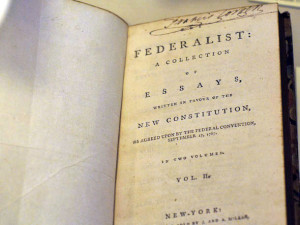
The federalist: a collection of essays New-York: printed and sold by J. and A. McLean, 1788 Porteus Library RDb/Ham – SHL
In March and April 1788, New York publisher J. & A. MacLean, published the first bound collection of the Federalist papers. The two volumes held in Special Collections at Senate House Library were published by the MacLeans and date from the period of the ratification debate. Albert Gallatin sided with the Anti-Federalists during the ratification debate. Like many in the Anti-Federalist camp, he argued that the document did not provide adequate safeguards for the preservation of liberty. Many of his concerns would be addressed with the passing of the first ten amendments to the Constitution (the Bill of Rights) after the Constitution was ratified.
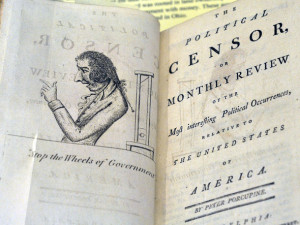
Political Censor, or Monthly review of the most interesting political occurrences William Cobbett Philadelphia: Printed for Benjamin Davies, 1796 Burns 3186-3194 – SHL
The 1790s were a turbulent decade for the early American Republic. The passions that raged during the debate over the ratification of the US Constitution were channelled into increasingly partisan political debates in the years that followed. The decade also witnessed the spread of radical ideologies throughout Europe as a result of the French Revolution, a development that many in the Federalist Party thought might ultimately destabilize the United States. In this tense political environment, prominent immigrants, especially those with radical sympathies, became targets of the Federalist Press. William Cobbett, a pro-British writer and publisher, attacked Gallatin for his support of Jefferson and the Republicans, his “French” manners, and his questionable loyalty to his adopted country. Gallatin is depicted as a luxurious Frenchman (he was actually from Geneva) representing “Whiskeyland” (western Pennsylvania, where an armed rebellion against federal taxes took place in 1791). There is some controversy over the image depicted here, it either represents Albert Gallatin or, more likely, Thomas Paine in front of a Guillotine – a reminder of the fate that might befall the United States if Jefferson and the “friends of France” ever came to power.
The Republicans in Power
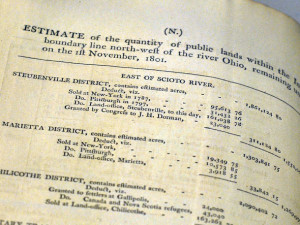
Letter from the Secretary of the Treasury accompanying a report Published by the order of the House of Representatives [s.n.], 21st December 1801. Bound in volume Reports of the Treasury 1801-13 – IHR
Thomas Jefferson and his supporters swept into power during the election of 1800. In 1801, Albert Gallatin was appointed the 4th Secretary of the Treasury and was responsible, in large part, for the implementation of Jefferson’s economic policies. Land and the western expansion of agriculture were key to Jefferson’s vision for the country as an agrarian republic. The sale of western lands, one of the central revenue-raising measures pursued under Jefferson’s leadership, therefore had the dual benefit of spreading republican virtue, a quality the Jeffersonians believed was rooted in land ownership while simultaneously providing the government with money. These government reports show the sale of government land in Ohio.
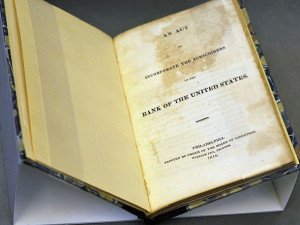
An Act to Incorporate the Subscribers to the Bank of the United States Philadelphia: Printed by order of the Board of directors (William Fry, printer), 1816 [G.L.] E.816 – SHL
The establishment of the Bank of the United States became another issue over which the two main political parties of the 1790s (Federalists and Jeffersonian Republicans) clashed over. The Federalists argued that the Bank was crucial to the encouragement of American industry, while the Republicans argued that it benefited rich merchants over the majority of population and that it eroded the republican virtue of the agrarian republic. In 1811 the senate allowed the charter of the first Bank of the United States to expire. While he had initially opposed the Bank while in congress, Gallatin changed his mind and became a supporter of the re-establishment of the bank in 1816.
The Northeast Border Dispute

Maine North Eastern boundary Pamphlets vol. 1 . Bound in volume Resolutions of the legislature of the State of Maine – IHR
This 1832 map, one of five in a bound volume containing fifteen pamphlets relating to the Northeastern Boundary Dispute (1783-1842), shows three proposed borderlines between Canada and the United States. The red line represents the British/Canadian claim and the green the American position. The yellow line denotes the compromise solution recommended by the third party arbitrator in the dispute – William I, King of the Netherlands. Though rejected by the American negotiators when it was first proposed in 1831, the Dutch compromise (with a few alterations benefiting the British) was ultimately accepted by the United States in the Webster-Ashburton Treaty of 1842. This volume was once owned by Gallatin.
This pamphlet calling for the reform of the Bank of Upper Canada was sent to Gallatin in 1830 by controversial Canadian politician, William Lyon Mackenzie (1795-1861). Mackenzie is best known as the first mayor of Toronto and for the role he played in the failed Upper Canada Rebellion of 1837-8. During the rebellion Mackenzie led an expedition of rebels to the outskirts of Toronto in 1837 and later declared himself the head of the ‘Canadian Republic’ before the rising was put down by British troops in January 1838. The inscription on this pamphlet reads, ‘To the Honourable Albert Gallatin, New York. York, Upper Canada, June 26, 1830. With W.L. Mackenzie’s Compliments’.

